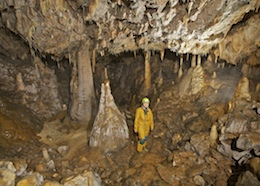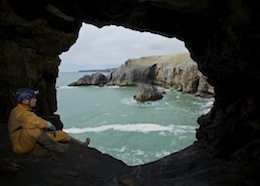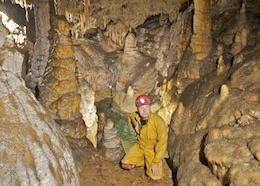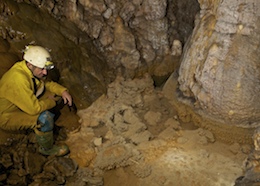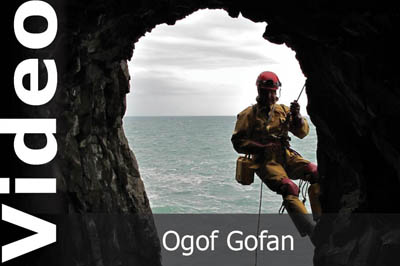Overview
The cave consists of a series of low crawls with two openings into the cliff face that lead through some small chambers to emerge into a large well decorated chamber which is connected to a final chamber via a further short crawl.Length 125m
Altitude 15m
Grid Reference SR 95810 93010
History
The cave was first explored by Mel Davies in 1966.
Location
The cave is located in the sea cliffs of Saddle Head in part of the Ministry of Defence Castlemartin Firing Range. The main entrance is not visible from above or from any point on the headland. The second window can be seen looking back from further round Hollow Caves Bay.South West Wales Google map showing the general area of Ogof Gofan and other caves in the area.
Location map - showing location of car park
Access
Cavers should now contact the Cambrian Caving Council Access / Conservation Officer, ideally by email (click for link) to outline your plan and receive information about the site including how to find it and their pitch-rigging suggestions. The Cambrian Caving Council will pass your details to the National Park Ranger who will issue the permit also by email.
Description
Ogof Gofan is located in the sea cliffs of Saddle Head overlooking Hollow Caves Bay and is very hard to find. A climb down the slope at the head of the cliff leads to a small bench that overlooks the near vertical bottom section of cliff. A 10m abseil from a bench partway down the cliff drops you into a tall entrance, the shape of an inverted teardrop, from the bottom of which a steep slope leads up to a landing and the start of the cave passage. A metal stake near the top of the slope allows you to secure the rope and protect this short climb up. The top of the slope forms a small portal where SRT kits can be taken off. The cave starts as a squeeze through to a low crawl that leads through some well decorated passage to reach the First Chamber that has a large window with an impressive view of Hollow Caves Bay. This small chamber has a floor that slopes down towards the window, spray from the sea and organic covering of the floor can wake this very slippy. A drop down to the top edge of the floor leads along a short traverse around the back of the chamber and a climb up to a small chamber that overlooks it. Towards the back of this chamber is a smaller chamber where bones were found when the cave was first explored. Here the way on is up over a calcite flow and through a squeeze to reach the Fourth Chamber which contains some stal bosses. The way through is ahead taking care not to tread in the deep muddy puddles and to take a crawl through the low passage at the far end of the muddy pool to enter a passage with some fine stal bosses in. Here two passages lead back towards the previous chamber, but the route on is to climb up the stal flow to squeeze through into the Fifth Chamber, the main chamber of the cave. This large chamber has a ceiling covered with a profusion of straws and formations. The centre of the chamber has several massive stalagmites and one column that is over 5m tall. The formations in the centre of the chamber are surrounded by a crystal pool, part dried up at one side and with emerald green water in on the other. On the left hand side of the chamber as entered is an area of actively forming stal. Up behind these dripping formations is a short tight crawl that leads into a passage that links to the Sixth Chamber. The crawl enters immediately above a hole in the floor that leads down into loose boulders. The well decorated passage heads off for a few metres to open out into the final chamber. Many stal bosses are found and in the centre of the chamber is a shallow crystal pool. From this chamber there are a couple of pretty alcoves that can be entered, but all choke with calcite.
Tackle
Entrance pitch 15mThe pitch down to the main entrance is rigged from a small bench part-way down the cliff. Long slings allow rigging from natural rock projections located just above the bench. Rope protectors are essential. A short distance over the edge you head to the right (as looking at the cliff) and swing into the entrance portal. It is easiest to drop to the bottom of the portal and climb up the slope to reach the cave passage, where a metal stake can be found to tie off the end of the rope and allow cavers following to use the rope as a handline.
Video
References
Cambrian Cave Registry for Ogof GofanCaves of South Wales | Tim Stratford | ISBN: 1-871890-03-9 | Published by Cordee
The Caves of West Wales | Tony Oldham
Warnings
The cave is located on the Castlemartin Firing Range and cannot be visited when the range is in use.
Disclaimer
The photographs and information of this page has been provided to help cavers planning trips. Caving can be a dangerous activity, if you are interested in exploring caves please join a caving club so you can enjoy a safe introduction to this sport. Local caving clubs are listed on the links page or you can visit the 'New To Caving' website for more options.If you feel that any of the information is incorrect or should be updated please contact us.



